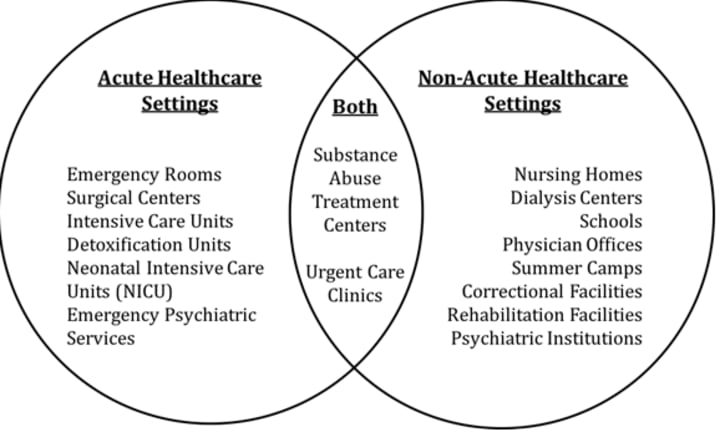The Difference Between Non-Acute and Acute Healthcare Settings
Whether you’re one of the approximately 10.3 million adults who gained access to healthcare between January 2012 and June 2014 or a healthcare provider, chances are you’ve heard the word ‘acute.’

Whether you’re one of the approximately 10.3 million adults who gained access to healthcare between January 2012 and June 2014 or a healthcare provider, chances are you’ve heard the word "acute."
You likely learned the term in your geometry class to refer to an angle less than 90 degrees, but that’s not what we’re talking about here. In medicine, the word "acute" can refer to an injury/illness or a type of healthcare environment. An acute injury is a sudden injury, usually associated with a traumatic event, such as a car accident or sporting misfortune. Acute injuries, like acute healthcare settings, are short-term and urgent in nature.
Healthcare professionals working in acute settings see patients on a short-term basis, treating urgent conditions. One common acute healthcare setting is an emergency room, where doctors, nurses, technicians, and other hospital staff see a large volume of patients in a short period of time. Acute settings are demanding, fast-paced environments that serve patients who are very ill or in critical condition. Medical providers working in acute settings are more removed from the lives of patients, thus rarely cultivate relationships with them. Think of an acute healthcare setting as a fast-paced drive-thru coffee shop, such as Starbucks or Dunkin Donuts.
But what about a healthcare environment that is not acute?
If a healthcare setting is non-acute, it is more for maintenance or long-term care. Non-acute healthcare professionals treat non-urgent matters. Non-acute is a catch-all of sorts, encompassing care for chronic conditions, outpatient preventative care, and more. Healthcare professionals working in non-acute settings see patients multiple times, cultivating a supportive relationship and ensuring a continuum of care for each patient.
Non-acute healthcare environments tend to be slower-paced, preventing burnout for providers and allowing healthcare professionals to grow personally and professionally. Non-acute healthcare providers enjoy more autonomy and independence in their work, along with the accompanying broader range of responsibilities, as they tend to work in smaller teams with fewer consults or backup providers available. Think of a non-acute healthcare environment as your local, independently-run coffee shop.
Most people utilize both acute and non-acute healthcare services over the course of their lifetime. Some healthcare services ca even be considered both acute and non-acute:

So you may be wondering how acute and non-acute care are defined in terms of substance abuse treatment centers and urgent care clinics. Well, let’s look at substance abuse treatment centers. Substance abuse treatment centers encompass detoxification, therapy/counseling, and recovery. Many individuals who enter into substance abuse treatment are not abstaining from the substances for which they are seeking treatment, so the acute component is detoxification. After a patient completes the detoxification process, he or she can begin non-acute treatment through therapy, support groups, and learning healthy behaviors to cope with their cravings.
Regardless of the limited overlap, acute and non-acute healthcare environments are very different. For example, nearly 118,000 patients received care in the emergency departments at University Medical Center (UMC) in Las Vegas, an average of 324 patients each day. UMC, like many other acute care environments, is fast-paced and ever-changing. Every day presents a new set of challenges to overcome and patients to treat. While the excitement of the acute care culture may be suited to certain types of nurses, it is not for everyone.
So before you dive head-first into that nursing school in Las Vegas, do your due diligence in asking about the curriculum and if it specializes in one type of care over another. Though it’s important to note that no matter the type of curriculum you’ll be exposed to, the only way to really know which environment is right for you is to try it out. Whether you end up in a fast-paced acute-care setting like University Medical Center, or ease your way into the field through a non-acute setting like a local doctor office, you can rest assured the nursing industry is only growing, and opportunities on either side of the fence most certainly abound.
About the Creator
Enjoyed the story? Support the Creator.
Subscribe for free to receive all their stories in your feed. You could also pledge your support or give them a one-off tip, letting them know you appreciate their work.





Comments
There are no comments for this story
Be the first to respond and start the conversation.